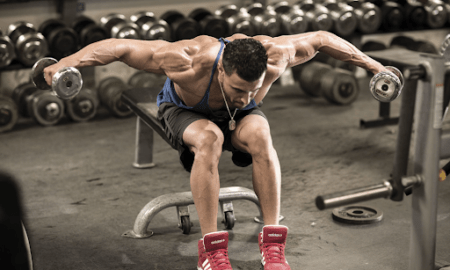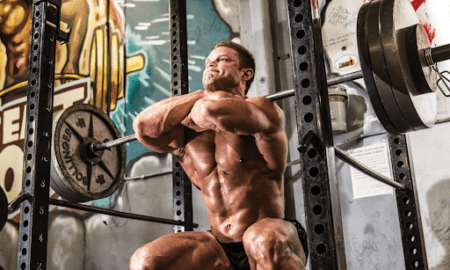Q: I started working out and eating healthfully in January, as I’d finally had enough of being out of shape. I started slowly, walking and doing a cycle of machines to work my entire body three days a week. I began reading articles online and in magazines. I’m now lifting more free weights and am using a split routine, and I’m running. I absolutely love this lifestyle, love the way I feel while working out and afterward. I wish I’d tried it when I was younger. I started visiting Web sites such as yours to motivate me. Understanding the amount of time and effort you put into looking that good really drives me to work harder—so thank you. Is there any advice you can give me to take my workouts to the next level? Like certain supplements or exercises or a particular bodypart split?
A: Congratulations on making the transition to the fitness lifestyle. As you’ve discovered, it’s never too late to get in shape and turn your life around. Exercising regularly and eating correctly are the best way to have a high-quality life and to look and feel good.
You seem to have started out the right way. You got your cardiovascular system in shape by walking several times a week. You also trained your muscular system with resistance exercises performed on machines.
From there you progressed to training with free weights and running. As I’m sure you’ve discovered, training with free weights is much more challenging than using machines, just as running is much more difficult than walking.
If you’ve been doing a full-body routine using free weights for 10 to 12 weeks, it’s all right to progress to a split routine. As you know, that involves adding more exercises for each muscle group and training your body over two or more days instead of working every muscle group in one workout. Although that may mean you work out four days a week as opposed to three days, you actually work each muscle group less often. On the splits I have in mind, you train each muscle group only twice a week. That’s necessary because of the increased workload.
You can split up the bodyparts in several ways. Use the routine you like best so you look forward to each workout. One method is the push-pull system. You train all the pushing muscles (chest, deltoids, triceps) in one workout and the pulling muscles (back, biceps) plus legs in the next one. The push-pull routine is a good one because there’s no danger of training the same muscle groups two days in a row.
Another method of splitting your workouts is to train chest, back and shoulders at one session and legs and arms at the other session. Many bodybuilders like that approach. One advantage is that the chest, back and shoulders are all close to each other, so training them together gives you a great pump. Another benefit is that you train your legs with your arms. It’s difficult to train legs with a major muscle group like back or chest. Training them with smaller muscle groups, like the arms, is much more efficient.
Here’s an example of two routines using both methods:
Routine 1: The Push-Pull Method
Monday and Thursday
Bench presses 4 sets
Incline presses 3 sets
Flyes 2-3 sets
Military presses 3 sets
Lateral raises 3 sets
Barbell shrugs 3 sets
Pushdowns 3 sets
Parallel-bar dips 2-3 sets
Seated calf raises 3 sets
Tuesday and Friday
Hanging knee raises 2-3 sets
Crunches 2-3 sets
Squats 4 sets
Leg presses 3 sets
Leg curls 3 sets
Stiff-legged deadlifts 2-3 sets
Wide-grip chins 3 sets
Barbell rows 3 sets
Incline curls 2 sets
Barbell curls 2 sets
Routine 2: Alternate Method
Monday and Thursday
Bench presses 4 sets
Incline presses 3 sets
Flyes 2-3 sets
Wide-grip chins 3 sets
Barbell rows 3 sets
Seated cable rows 3 sets
Military presses 3 sets
Lateral raises 3 sets
Barbell shrugs 3 sets
Standing calf raises 3 sets
Tuesday and Friday
Hanging knee raises 2-3 sets
Crunches 2-3 sets
Squats 4 sets
Leg presses 3 sets
Leg curls 3 sets
Stiff-legged deadlifts 2-3 sets
Pushdowns 3 sets
Lying triceps extensions 2-3 sets
Seated dumbbell curls 2 sets
Barbell curls 2 sets
As for supplements, I’m sure by now that you’ve discovered the benefits of supplementing your diet with protein drinks. There are so many high-quality protein powders on the market these days that it’s easy to meet your protein requirement of 1.25 to 1.5 grams per pound of bodyweight.
I prefer a combination of milk, egg and whey proteins. That ensures that the protein will be digested and absorbed more slowly, providing muscles with a steady stream of protein for several hours. I use the Pro Complex brand from Optimum Nutrition.
You also should have a recovery drink immediately after you’re finished training. The postworkout drink combines whey protein with fast-digesting carbohydrates to restore the amino acids and glycogen in muscle cells. By taking in the drink within 30 minutes after finishing training, you increase your recovery and growth. Two excellent postworkout drink mixes are RecoverX by Muscle Link and 2:1:1 Recovery by Optimum Nutrition.
Q: I see your picture in IRON MAN every month and read your articles. You look fabulous for not being a juicer. That’s why I’d like your opinion on something. I’m 66 years old and have been training for 50 years. There’s not much training information for people over 60. I was Mr. Detroit in 1966 and Senior Ultra masters Mr. Arizona in 2008. I train hard, have a clean diet and take all of my supplements, but I can’t get the big, hard look with the separation I once had. Is it because of my age? Is there anything I can do? Any advice or tips you could share with me would be greatly appreciated. I’m 5’11”, 205 pounds and 23 percent bodyfat.
A: I can understand your frustration. It definitely gets more difficult to get ripped and into contest condition as we get older. Our metabolisms slow down because of the changes in our hormone levels.
After your mid-20s, both testosterone and growth hormone begin to decline. Testosterone is the primary hormone for mass and strength. Growth hormone is the primary hormone for regulating fat deposition on the body. The decline of those two important hormones makes a difference in your appearance.
The good news is that you’ve been training for most of your life, so you have a good amount of mass. It’s always easier to maintain muscle than it is to start building it in your senior years.
Although you may be somewhat smaller in size than you were 20 to 30 years ago, you’ll still be able to maintain much of your size by continuing to train with heavy resistance three to four times a week. Heavy weight training using the basic exercises also helps the body release testosterone.
You mentioned that you’re 5’11” and 205 pounds at 23 percent bodyfat. I’m not sure what method of bodyfat testing you’re using, but that seems very high for someone who’s been actively bodybuilding most of his life.
The key to getting the hard-and-ripped look is diet. I’m not sure what diet you’re following now, but you have to reduce your bodyfat by speeding up your metabolism, feeding the muscles and starving the fat cells. That’s all accomplished through the right nutrition program.
At 66 years old you’ll most likely have to eat fewer calories than you did when you were younger. If your bodyfat is really 23 percent, your lean bodyweight is approximately 158 pounds.
For your protein intake you want to eat 1.5 grams of protein for each pound of lean muscle tissue. That would equal 237 grams of protein each day: 158 x 1.5 = 237.
You should focus on eating lean protein such as egg whites, chicken breasts, lean ground turkey, lean red meat and fish. Those foods, along with a high-quality protein supplement, will maintain and build your lean muscle tissue as you lose bodyfat.
You’ll have to carefully watch your carbohydrate intake if you want to get lean and ripped at your age. Focus on complex carbs that are high in fiber and digested very slowly. Oatmeal, sweet potatoes, brown rice and whole-grain bread are great for restoring and supplying the muscles with glycogen without causing excess fat storage.
I’ve found that, as I get older, I have to cut back more and more on my carbohydrates. You’ll have to experiment to see how many carbs you can take in while consistently losing fat.
I like to cycle my carb intake so that I’m getting more on my weight-training days and less on my rest days. By alternating, I keep the muscles full while simultaneously starving the fat cells.
You may need to lower your carbs to only 150 grams on your training days and as low as 100 grams on your nontraining days. As I said above, you’ll have to experiment to discover the exact number, but I think that would be a good place to begin at your age and weight.
Don’t forget to get adequate amounts of the essential fatty acids. I always supplement my diet with flaxseed oil—two tablespoons per day, added to my protein drinks—and foods that are high in the essential fatty acids, such as salmon.
Putting it all together, if you ate 237 grams of protein, 100 to 150 grams of carbs and 50 grams of fats per day, your calorie intake would vary from 1,986 on your training days (with 150 grams of carbs) to 1,786 on your nontraining days. The macronutrient breakdown would look like this:
Training Days
1,986 calories
237 grams of protein
150 grams of carbohydrate
50 grams of fat
47 percent protein, 30 percent carb, 23 percent fat
Rest Days
1,786 calories
237 grams of protein
100 grams of carbohydrate
50 grams of fat
52 percent protein, 22 percent carb, 25 percent fat
Getting ripped in your 60s is more difficult, but it’s attainable. My friend Murrell Hall from Decatur, Illinois, is a great example. Murrell is 68 years old, and he is ripped and rock hard all the time. He has been competing for 30 years, and he never lets himself get out of shape. In fact, I think he has to lose only about five pounds to get ready for a contest.
Murrell eats the same diet day in and day out. He hasn’t had a slice of pizza in more than 30 years, and he goes off his diet only on the night of his competition, when he lets himself have a hamburger with french fries. I think that’s the key to Murrell’s success in bodybuilding—consistently staying lean and ripped and never allowing himself to gain any fat. It’s much easier to get in shape when you never get out of shape.
Start recording your diet every day. Keep track of the calories, protein, carb and fat you take in on a daily basis. Follow my guidelines, and take it from there. When you start writing everything down, it will be much easier for you to figure out what you need to do to get that ripped, winning physique.
Editor’s note: John Hansen has won the Mr. Natural Olympia and is a two-time Natural Mr. Universe winner. Check out his Web site at www.NaturalOlympia.com, or send questions or comments to him via e-mail at [email protected]. Look for John’s DVD, “Natural Bodybuilding Seminar and Competitions,” along with his book, Natural Bodybuilding, and his training DVD, “Real Muscle,” at his Web site or at Home Gym Warehouse, www.Home-Gym.com. Listen to John’s new radio show, “Natural Bodybuilding Radio,” at www.NaturalBodybuildingRadio.com. You can send written correspondence to John Hansen, P.O. Box 3003, Darien, IL 60561. IM




















You must be logged in to post a comment Login